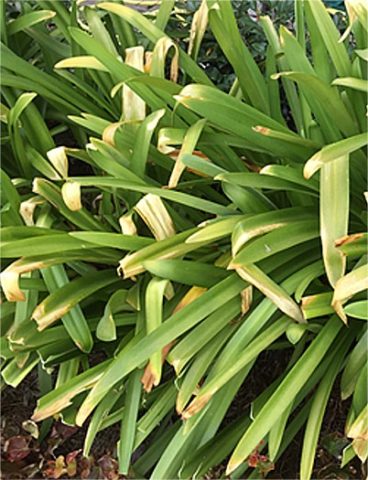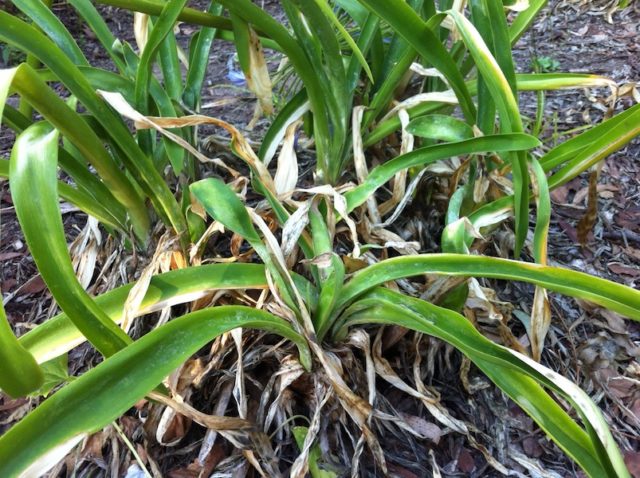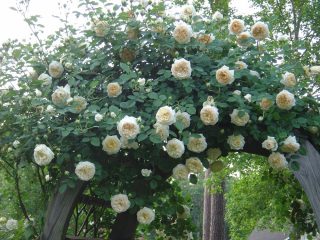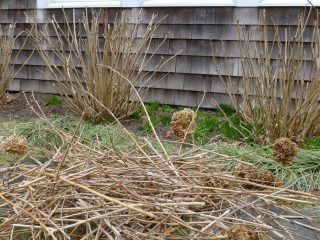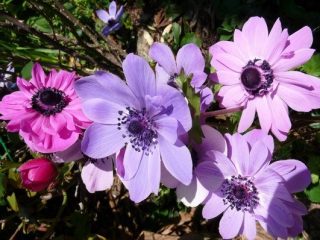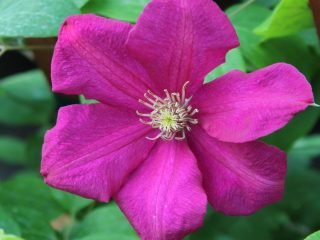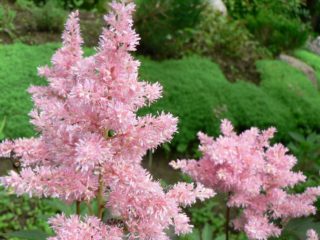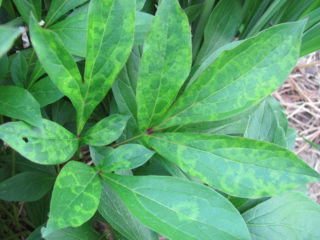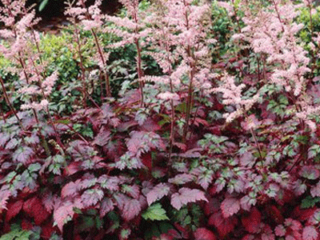Content
The agapanthus flower, an ornamental herbaceous perennial, was given to the world by South Africa. This is a spectacular lush plant, replete with long thick leaves, and for a long time it is decorated with delicate bright flowers of unusual shape. Not many species of agapanthus are known, but they are able to effectively cross-pollinate, forming interesting hybrids. Today this plant is successfully grown both in open ground and in flowerpots on windows. Propagating and planting agapanthus is not difficult, and caring for it is also very simple.By providing it with favorable conditions, fertile soil, moderate watering, wintering indoors or shelter for the winter, an abundance of light and warmth, you can quickly get a beautiful and original flower that looks great in a room, in a flower bed or in a flower garden. In addition, agapanthus rhizome has a number of beneficial properties and is used in folk medicine.
General description of the plant
Agapanthus is a genus of flowering herbaceous perennial plants, currently classified as a separate family, Agapanthus. This unusual and very decorative flower is also known under the poetic folk names African lily, Lily of the Nile, Abyssinian beauty. Agapanthus was brought to Europe in the 17th century.
In fact, it does not have much in common with lilies; first of all, there is some external similarity in the shape of the flowers of these plants. At the same time, previously Agapanthus was classified as a member of the Liliaceae family, then - to the Amaryllis family, and after that - to the Onion family. But the references to the hot continent are not groundless, since in the wild it grows exclusively in the Cape Region (at the Cape of Good Hope), along the ocean coast and on the slopes of the mountains.
This plant has a powerful, branched creeping rhizome with short fleshy roots.
Its long, elongated leaves are usually dark green in color. They have a lanceolate shape and a noticeable thickening at the very base; their length can reach 20-70 cm. The leaf blades of the plant are collected in dense, dense basal rosettes.
In mid-summer, before flowering begins, a long peduncle, otherwise called a “false stem,” grows from the rhizome of agapanthus.Its length varies from 0.5 m for dwarf plant species, to 1-1.5 m for the rest. It is a strong bare tube, at the top of which there is a spherical inflorescence. This is a large raceme (15-25 cm in diameter), consisting of 20-150 small elongated funnel-shaped flowers of 6 petals, which are attached to the stem of the peduncle with short petioles. Their color can be varied: white, blue, light blue, lavender, blue-lilac.
A photo will help you imagine what an agapanthus flower looks like:
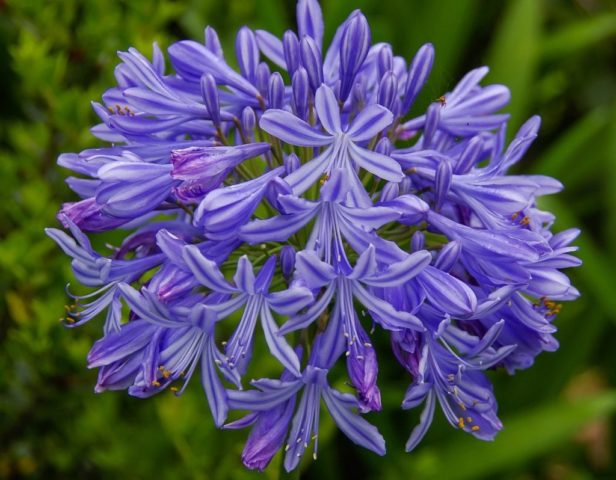
The inflorescence of agapanthus resembles a ball, consisting of 20-150 small elongated flowers, and rests on a high peduncle
This plant usually blooms for 1-2 months, but the rest of the time it remains very decorative thanks to the lush mop of green leaves.
The fruit of Agapanthus is a capsule with multiple flat brown-black seeds. They ripen 1-1.5 months after the end of flowering of the plant.
Features of reproduction
There are three ways to propagate agapanthus:
- growing from seeds;
- dividing the bush;
- rooting of shoots.
Propagation of this plant by seeds is not always successful. In addition, if the flowers turn out to be over-pollinated, it is possible that the seedlings will not show the characteristic characteristics of the desired variety. It is also known that plants obtained from seeds begin to bloom 5-7 years after sowing. Due to all this, this method is not used so often.
A more popular and easier option for propagating agapanthus is dividing an adult plant. It allows you to immediately get two developed specimens ready for flowering.
Agapanthus can be divided twice a year:
- in the fall, after it has time to bloom;
- in spring, before flower stalks appear.
You should proceed like this:
- carefully dig up the agapanthus bush along with the roots;
- carefully clean the rhizome from the soil;
- Using a sterile sharp knife, cut it into two parts so that each of them has its own rosette of leaves;
- sprinkle the cut areas with crushed activated carbon;
- let the cuttings stand for several days, covering the roots with a moist substrate;
- after that, root them into the ground in a place of permanent growth.
The third method is based on the fact that in an adult plant, young daughter shoots are often formed next to the main basal rosette. These “babies” of agapanthus can be carefully separated without digging up the bush and planted independently. The main thing when carrying out this procedure is not to damage the roots of the seedling and the mother specimen.
Types and varieties
There are few described species of Agapanthus. However, they are all capable of effectively crossing with each other, resulting in interesting hybrid varieties.
Agapanthus africa
The species Agapanthus africanus has another name - Agapanthus umbellatus. It began to be grown as a cultivated plant in Europe since 1824. It belongs to the evergreen agapanthus.
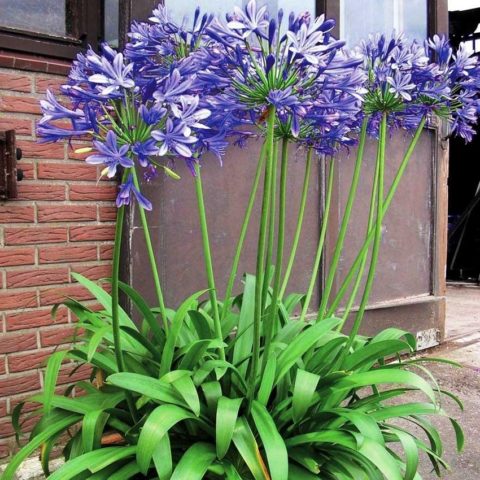
African agapanthus hybrids are very common in garden and indoor floriculture.
Its height can reach 0.6-1 m. On narrow (up to 2 cm) dark green leaves, a light longitudinal stripe is clearly visible. The length of the plates is usually 30-60 cm. The diameter of the umbrella inflorescence reaches 25 cm; 20-40 flowers are usually collected in one brush.Their color varies depending on the plant variety: it can be white, blue, light blue, or purple.
Flowering of African agapanthus begins in mid-July and lasts until the second half of September. In its “pristine” form, this plant is almost never found in cultivation, but its hybrids are very common and are well adapted to growing in apartment conditions.
Agapanthus orientalis
The species Agapanthus orientalis is also called early Agapanthus (Agapanthus praecox). This is an evergreen plant. It is distinguished from African Agapanthus by lighter, wider and slightly curved leaf blades, as well as shorter peduncles (up to 60 cm). It does not grow tall - only about 60-75 cm.
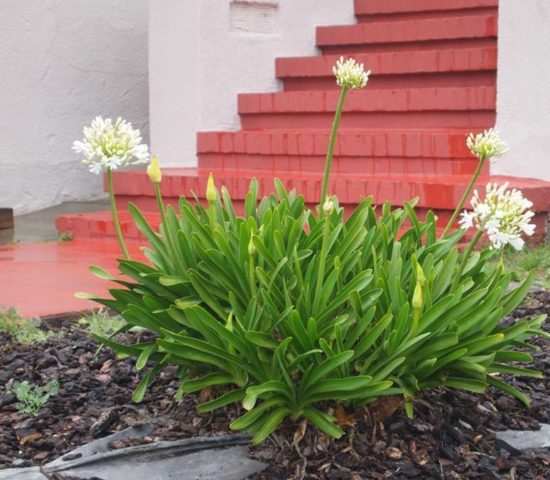
Agapanthus eastern (early) is very decorative during and after flowering
This agapanthus is characterized by a delicate porcelain blue color of the flowers. Each inflorescence contains from 50 to 100 buds and therefore is shaped like a large ball up to 40 cm in diameter.
Oriental Agapanthus blooms from mid to late summer.
Agapanthus bellflower
Agapanthus campanulatus is a deciduous species. In nature, it grows mainly on wet mountain slopes. Its linear, fleshy, erect leaves reach 15-30 cm in length and 3 cm in width, forming dense bushes. During the cold winter period, they fall off, and the plant enters a dormant period, after which it again increases its green mass.
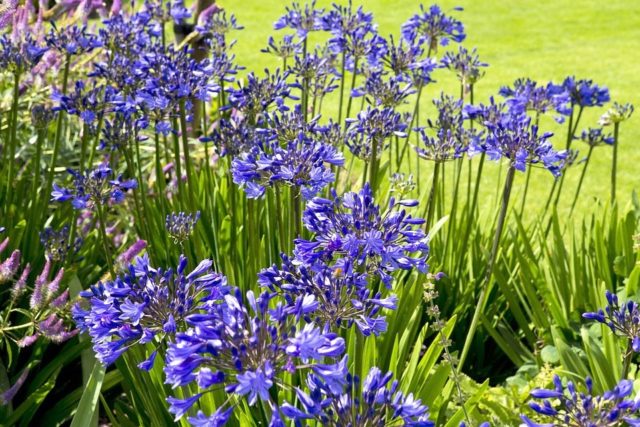
Agapanthus bell-shaped is a deciduous species that sheds green mass during the dormant period
The flowering of this agapanthus can be observed in July-August. Loose umbrellas are held on the tops of numerous half-meter peduncles. Each of them contains up to 30 flowers of a characteristic bell-shaped form.They are usually painted in a soft blue (less often lilac or white) color.
Agapanthus closed
Closed Agapanthus (Agapanthus inapertus) is a deciduous species. It begins to bloom in August, and the bells that form in the inflorescences appear drooping and do not fully open throughout the entire flowering period, ending in mid-October.
The length of its leaves is usually 60-90 cm, width - up to 6 cm, their color is green with a blue tint and a faint bluish bloom. Peduncles reach 1.5 m in height. The flowers are dark blue or purple.
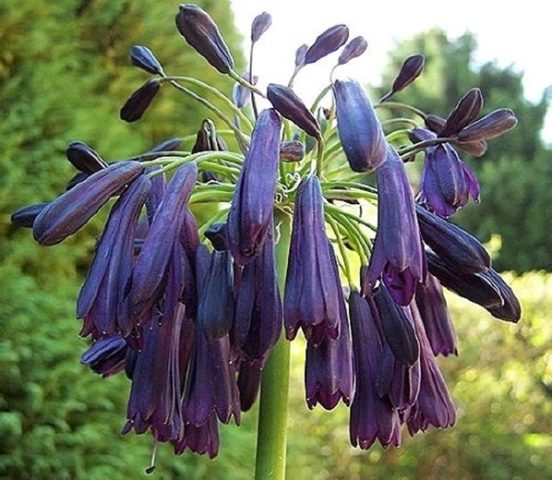
The drooping flowers of Agapanthus closed never open fully, looks very beautiful indoors on a sunny window
Hybrid ornamental agapanthus
Today, many ornamental garden and indoor varieties of agapanthus have been bred, which differ in the shape and color of flowers, leaves, and the height of peduncles. It is worth dwelling in more detail on the description of some of the most interesting of them.
Peter Pan
Peter Pan is a dwarf hybrid of African agapanthus, reaching a height of about 30-45 cm. The large caps of its flowers (up to 15 cm in diameter) are painted in a soft blue color. In central Russia and the Moscow region, this agapanthus is grown indoors - in pots or tubs, but in warmer climates it can also grow in open ground. In the flower bed, Peter Pan usually blooms from June to October, although if there is a nearby heat source, flowers may appear in the winter. This plant looks good cut as part of bouquets.
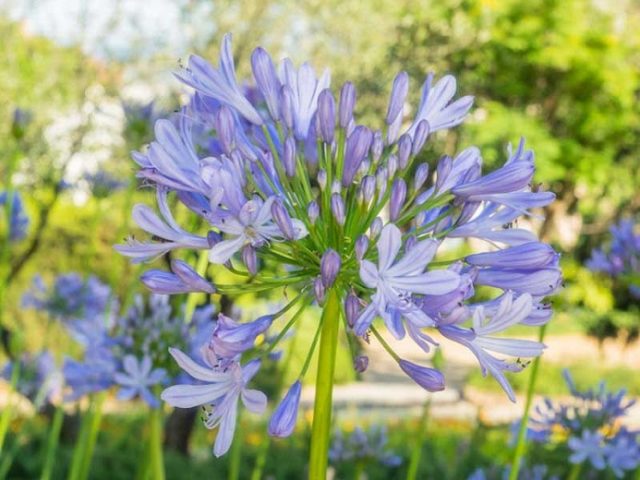
Peter Pan - the famous dwarf hybrid with pale blue flowers
Blue
Agapanthus Blue, or Blue, can be grown both in the garden and on the balcony.The length of its peduncles reaches 0.7-1 m, and numerous flowers from 2 to 3.5 cm in diameter have a rich blue color. Blue is an evergreen hybrid of umbrella agapanthus that does not lose leaves if it is transplanted from open ground into a box for the winter and kept indoors. The flowering period of the plant is from July to the end of September.
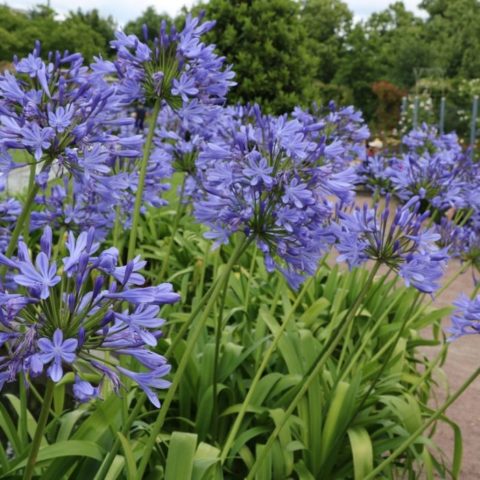
Blue grows well in the garden and on the loggia
Baby Blue
Baby Blue is a dwarf compact bush 15-20 cm high. Thick, durable stems bear dense baskets of dense, elongated flowers of lilac-blue color. A characteristic feature of the plant is the edge on the peduncles and the underside of the leaves. Late flowering variety (late July or even October). It is highly drought-resistant.

Baby Blue - deep blue dwarf agapanthus
White
Agapanthus White, or White, looks very decorative thanks to the lush white inflorescences on peduncles of medium height (0.7-0.8 m), the background of which is dense rosettes of dark green leaves. The buds open gradually, and due to this, the flowering of the plant lasts a long time, usually from July to September. If Agapanthus White is grown indoors, it is advised to take it out into the garden or onto an open balcony for the summer, otherwise you may not be able to wait for flowering.
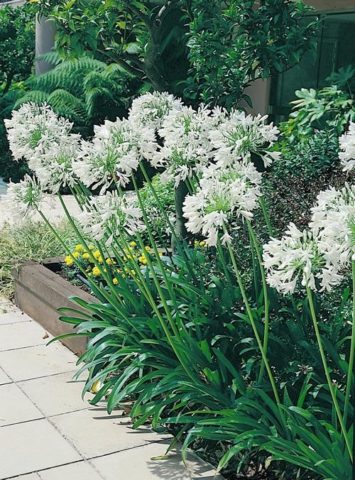
Luxurious white inflorescences of the White variety will decorate any flowerbed
Black Buddhist
Agapanthus Black Buddhist is known for its unusual, almost black stems and violet-blue flowers. In this case, a longitudinal dark stripe is clearly visible in the center of each petal. It grows up to 60-90 cm. The plant has straight leaves of a rich green color, which are shed for the winter. Flowering lasts from mid-July to the end of August.
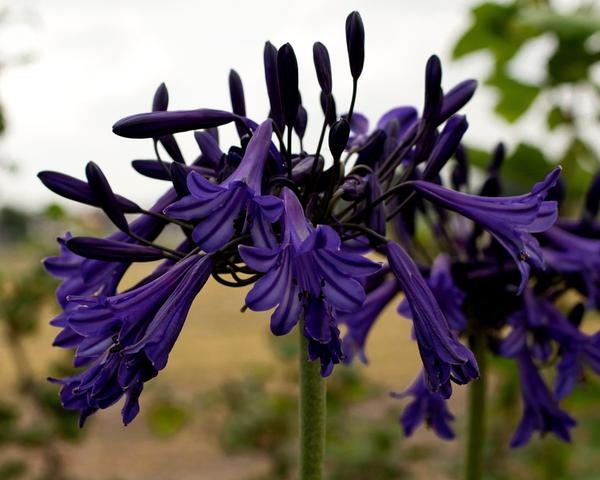
The original blue-violet inflorescences of Black Buddhist look very unusual
Fireworks
The Fireworks variety, or Fireworks, looks very original due to the contrasting color of the elongated tubular flowers, the lower part of the petals of which is bright lilac, and the upper part is snow-white. Combined with the lush green leaves, the plant looks stunning in the garden or window. Agapanthus Fireworks does not grow tall (30-60 cm). Flowering, depending on climatic conditions, begins in mid or late summer.
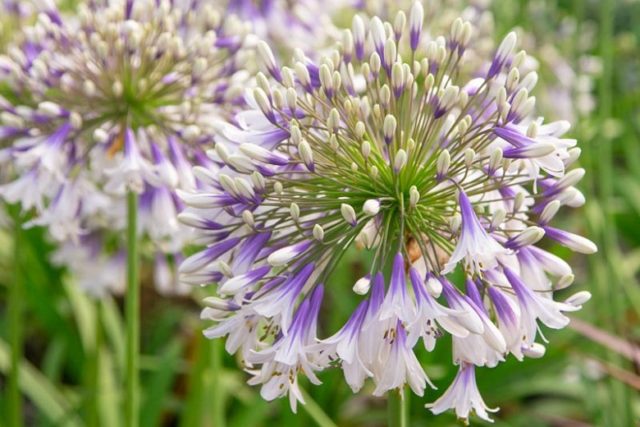
The bright “bells” of the Firework variety are painted in two contrasting colors
Variegata
Variegata is a hybrid of eastern (early) agapanthus, growing up to 30-60 cm. This plant has very beautiful long leaves with characteristic white-yellow stripes running parallel to the green central vein, and a yellow frame along the edge. Pale light blue, almost white flowers of the Variegata variety on 60-70 cm stems appear in mid-summer.
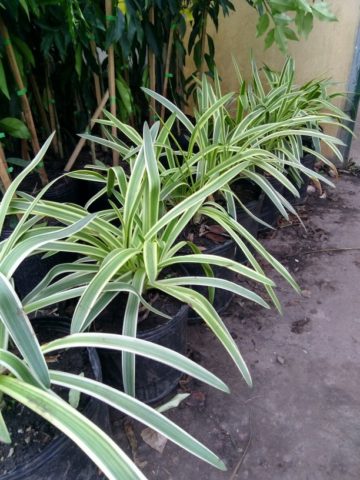
Variegata is characterized by striped yellow-green leaves
Albus
Agapanthus Albus (Albus) is a wonderful tall (60-90 cm) hybrid of African agapanthus. Its thick umbrellas on high peduncles at the height of flowering resemble large snow-white balls about 25 cm in diameter and attract the eye, decorating any corner of the garden. As a houseplant, it is convenient to grow a dwarf version of this hybrid - Albus Nanus, which does not grow higher than 40 cm.
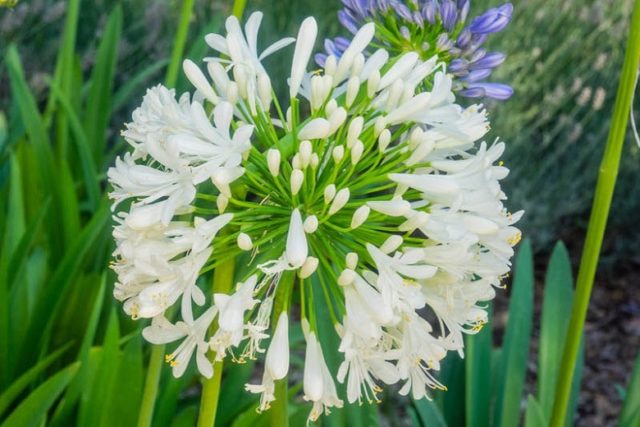
Snow-white Albus is equally beautiful in both tall and dwarf versions.
Tinkerbell
The dwarf hybrid Tinkerbell reaches only 45 cm in height, but looks very impressive.The graceful clusters of “bells” of this agapanthus are painted sky blue, and the green leaves are decorated with silver stripes. The Tinkerbell variety remains decorative even after it has faded.
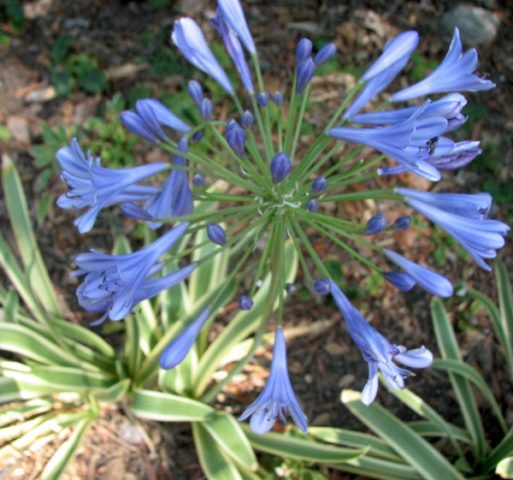
Baby Tinkerbell has soft blue flowers and silver stripes on the leaves.
Planting and caring for agapanthus at home
A gardener who wants to grow indoor agapanthus should become more familiar with the preferences of this plant and take care of creating the necessary conditions in the room chosen for it. In this case, you can get a beautiful and healthy flower that feels great all year round in a pot on the windowsill.
Sowing time
The optimal time for germinating seedlings from seeds is early spring (early March). The room where the containers with planting material will be kept must be warm - about + 24 ° C, otherwise the seedlings may not appear.
Preparing containers and soil
It is most convenient to use wide wooden boxes or containers as a planting container for growing agapanthus seedlings.
The soil should be:
- loose;
- nutritious;
- well drained.
Leaf soil mixed with sand or peat with perlite in a ratio of 1:3 is perfect for agapanthus seedlings.
Landing algorithm
Planting seeds is carried out as follows:
- a layer of drainage 3-5 cm thick is poured onto the bottom of the container;
- fill the container with soil and moisten it by spraying it with a spray bottle;
- make small holes in the substrate, place 1 seed in each;
- The seed should not be buried - just press it slightly into the soil with your fingers;
- The seeds are lightly sprinkled with soil or sand on top.
Next, the box needs to be covered with glass or a piece of film to create a “greenhouse effect”, and placed on a well-lit windowsill.
How to grow agapanthus from seeds at home
In order for agapanthus seeds to germinate successfully, it is necessary to take proper care of them immediately after planting:
- Remove the cover film or glass from the box 2-3 times a day for about 20-30 minutes, ensuring unhindered air access to the seeds. After the first shoots appear after 1-2 weeks, the “greenhouse” should be completely removed.
- Be sure to keep the soil moist, not allowing it to dry out, but also not flooding it too much. The ideal option is spraying from a spray bottle.
- After the seedlings have their 4th true leaf, they will need to be pruned. At this stage, the plants are planted in open ground or in individual larger pots with fertile soil.

After the appearance of 4 leaves, agapanthus seedlings can be planted in individual pots
Growing agapanthus at home
Caring for agapanthus at home is not particularly difficult. To keep the plant healthy and comfortable, it is enough to follow the following rules:
- Place the pot on the lightest windowsill (preferably on a south-facing window), making sure that the agapanthus is well protected from drafts.
- Water the flower regularly and carefully, without over-moistening the soil, otherwise the leaves may turn yellow and wither. It is advisable to use pre-settled water at room temperature.
- In spring and summer, it is recommended to feed agapanthus once a week with complex formulations. In winter, the flower does not need fertilizer.
- If the plant's inflorescences are very voluminous and large, it may require supports to prevent the flower stalks from breaking.
- Agapanthus does not like excessively hot temperatures. In summer, it is advisable to take it out to an open balcony, garden or terrace, if possible. In winter, the plant will feel good indoors at a temperature of about + 18 ° C.
Planting and caring for agapanthus in the ground
Growing agapanthus in open ground has its own characteristics. However, a plant planted in the garden has a number of advantages over one that is constantly in the apartment: it looks more powerful, develops faster and blooms more abundantly.
Transplanting seedlings
Agapanthus seedlings are usually transferred to open ground in early or mid-May. By this time, the weather should already be consistently warm outside (not lower than + 10-12 °C).
The place for planting agapanthus should be selected according to the following criteria:
- well lit, sunny, with slight shading during the midday hours;
- protected from gusts of wind and drafts;
- neutral or slightly acidic soil.
The composition of the soil should be nutritious:
- 2 parts humus;
- 2 parts of turf land;
- 1 part peat;
- 1 part sand.
The procedure for planting agapanthus seedlings in the ground is as follows:
- Shallow holes (about 8 cm) should be dug in the area. If you plan to plant several plants, the distance between them should be at least 0.5 m.
- Seedlings must be carefully removed from the pots so as not to damage the roots.
- Place each plant in the hole, straightening the root system, sprinkle with soil and carefully compact it.
- After this, it is necessary to mulch the soil at the roots of the agapanthus so that it better retains moisture.
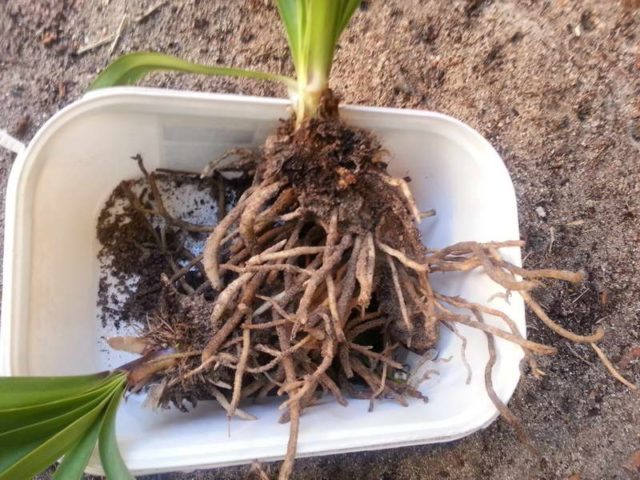
When digging up or replanting agapanthus, it is extremely important not to damage its root system.
Watering and fertilizing
Agapanthus growing in an open area should be watered frequently as the top layer of soil dries. The amount of water should be moderate: if the bulbs are over-wetted, the plants may rot. With the onset of cold weather, watering the flower should be done as rarely as possible, only after the soil has dried thoroughly. In winter, they stop moistening the soil completely, except for the situation when the agapanthus in a tub is transferred from the garden to a heated room before spring. In this case, the plant does not enter a period of rest, and it must be watered as needed, making sure that the roots do not dry out too much.
The feeding regime for agapanthus is simple: at the stage of budding and flowering, complex fertilizers for flowering plants should be applied to the soil 2 times a month. It is also effective to alternate mineral compositions with organic ones, until the end of the flower’s growing season.
Wintering Agapanthus
It is known that agapanthus growing in the ground can withstand air temperature drops of up to + 10 ° C if it is an evergreen species, and up to + 5 ° C if it is deciduous.
Based on this, in the southern regions of Russia, agapanthus can winter in open ground, provided that it is provided with reliable shelter from coniferous spruce branches or a thick layer (20–0 cm) of fallen leaves or sawdust.
If the garden is located in a colder region, where the air in winter cools below the designated maximum temperatures, then it is necessary to organize the wintering of agapanthus differently. To do this, carefully dig up the plant with its rhizome, always leaving a lump of earth on it, place it in a box and keep it in a cool, dry room (basement) until spring, when it is planted in the ground again.
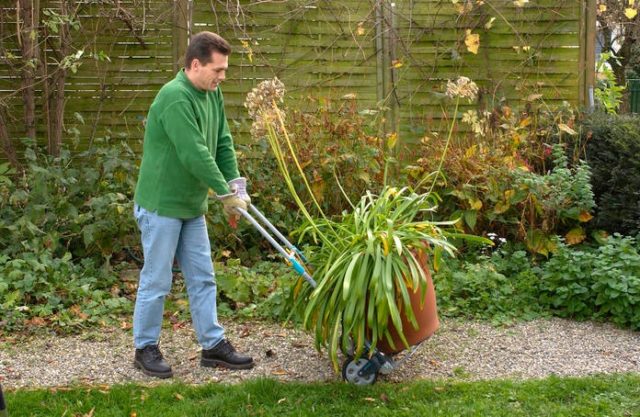
If agapanthus grows in a tub, it is convenient to put it away for the winter in a room or greenhouse without digging it out of the ground
Transplanting flowers
Agapanthus is rarely transplanted, as it does not tolerate it well. You should know that this plant blooms best if the pot is a little too small for it. Young and small-sized specimens can be replanted once every 3-4 years.
Pests and diseases
Observing the appearance of the plant will help to identify signs of diseases or pests in time and promptly eliminate this nuisance.
Most often, a gardener may notice such deviations from the norm:
- Yellowing of leaves. The reason for this may lie in excessively abundant watering. The soil moisture should be adjusted, and the plant will recover. Another possible reason is extreme heat. In this case, you should organize shading during the sunniest hours and provide the plant with sufficient moisture. The third option, which can be suspected if mainly young leaves turn yellow, is chlorosis caused by iron deficiency. Perhaps the acidity of the soil is increased, and the roots of the plant cannot absorb this element.The pH level of the soil under the agapanthus should be measured, and if it exceeds 7, it must be reduced to at least 6.5 by applying fertilizers containing calcium and magnesium.
Agapanthus leaves turning yellow may indicate sunburn.
- Too long, elongated peduncles. This occurs as a result of insufficient lighting. Agapanthus needs to be transplanted to a sunny area, the pot with the plant should be moved to a more illuminated window, or additional lighting should be provided.
If agapanthus does not have enough light, the flower stalks elongate and become fragile.
- Drying and dying of leaves. One of the most common reasons is an attack by pests (spider mites or scale insects). If the plant is slightly damaged, treating the green mass of agapanthus with a soap solution 2-3 times can help. You need to soak a cotton swab in it and wipe the leaf blades, manually removing pests. If the plant is severely damaged, it is advisable to spray it with insecticidal preparations (Aktellik, Fitoverm, Aktara).
The cause of leaf drying may be an attack by scale insects or spider mites.
Useful properties of the plant
Agapanthus is a plant known not only for its decorative, but also for its beneficial properties. Thus, it is recommended to grow it in apartment conditions, since it is believed that it is capable of absorbing heavy metals contained in the air, and during the flowering period it releases phytoncides - substances that have antibacterial and antimicrobial effects.
There is information that agapanthus rhizome can be used to treat inflammation or swelling, as well as to fight viruses. However, it should be remembered that the juice of this plant is poisonous, and upon contact with skin can cause severe irritation and an allergic reaction.
Conclusion
Agapanthus flower is a beautiful and undemanding perennial plant that looks very decorative during the flowering period and after it ends. It will be a wonderful decoration for the interior of a house or apartment, and will also look great in an open planting on the site, in a greenhouse or in a winter garden. Due to the fact that agapanthus of different species and varieties are easily crossed, there are many hybrids that differ in size, color and shape of leaves and flowers. Among them, you can easily choose one that will fulfill the wishes of any gardener.
